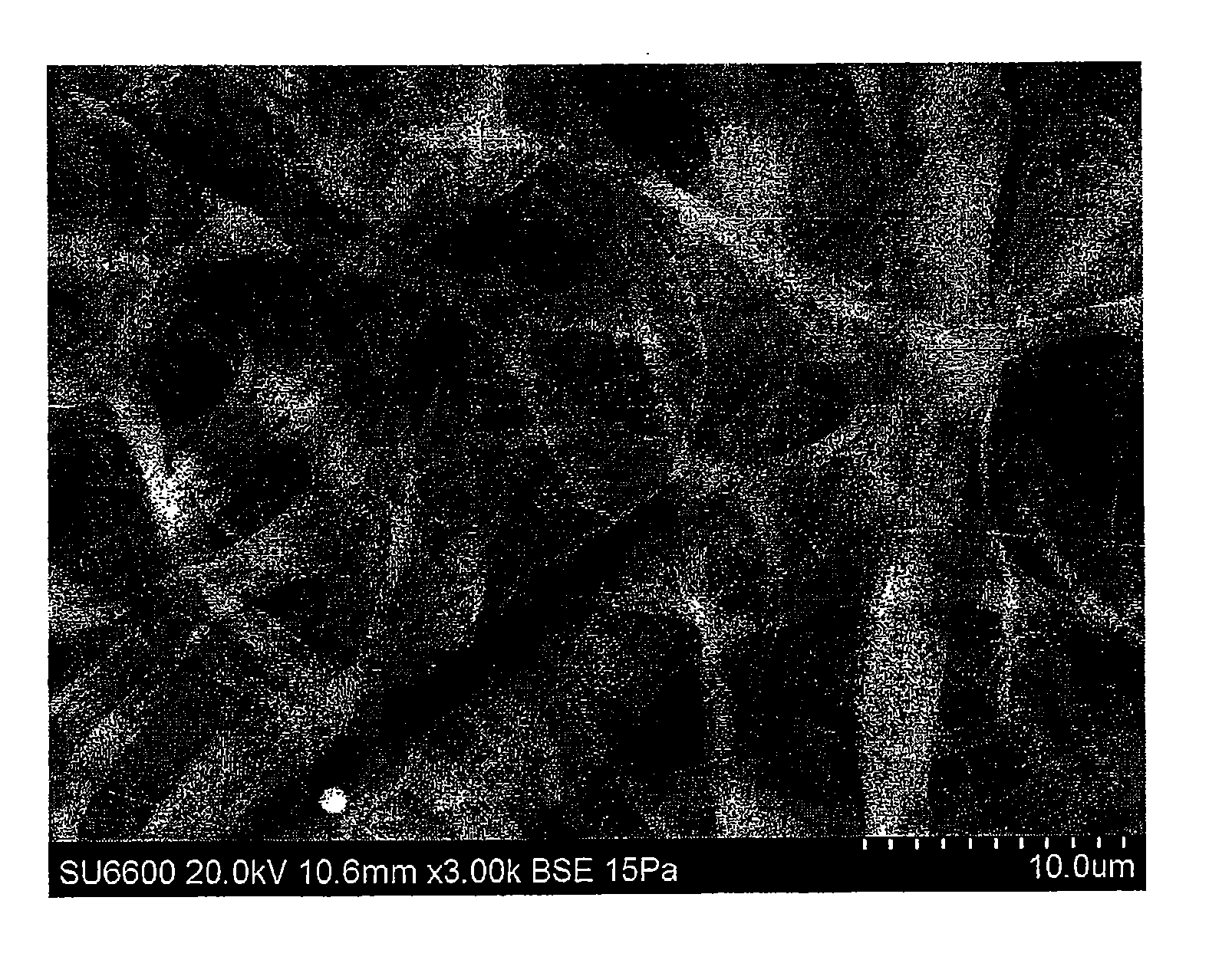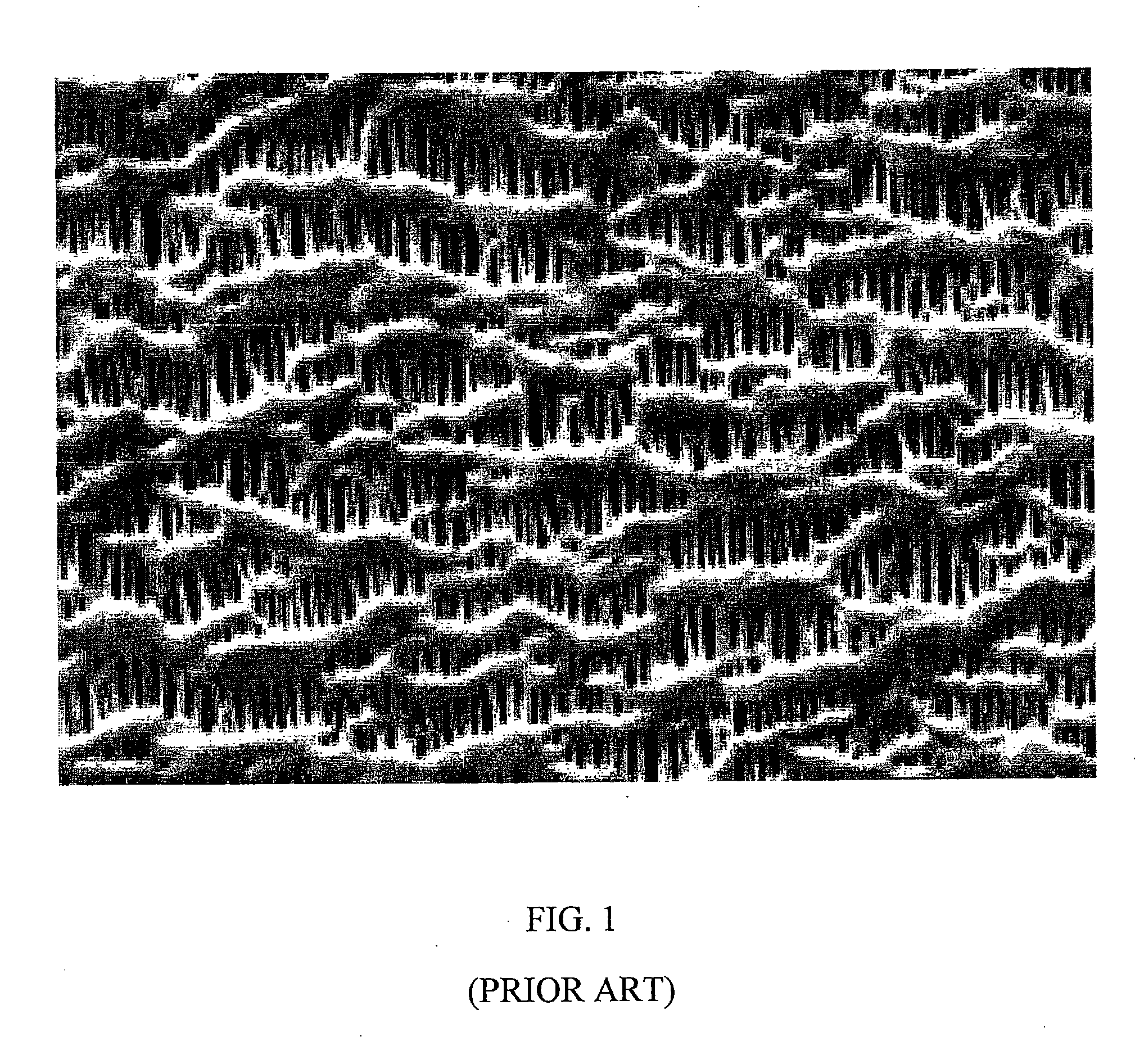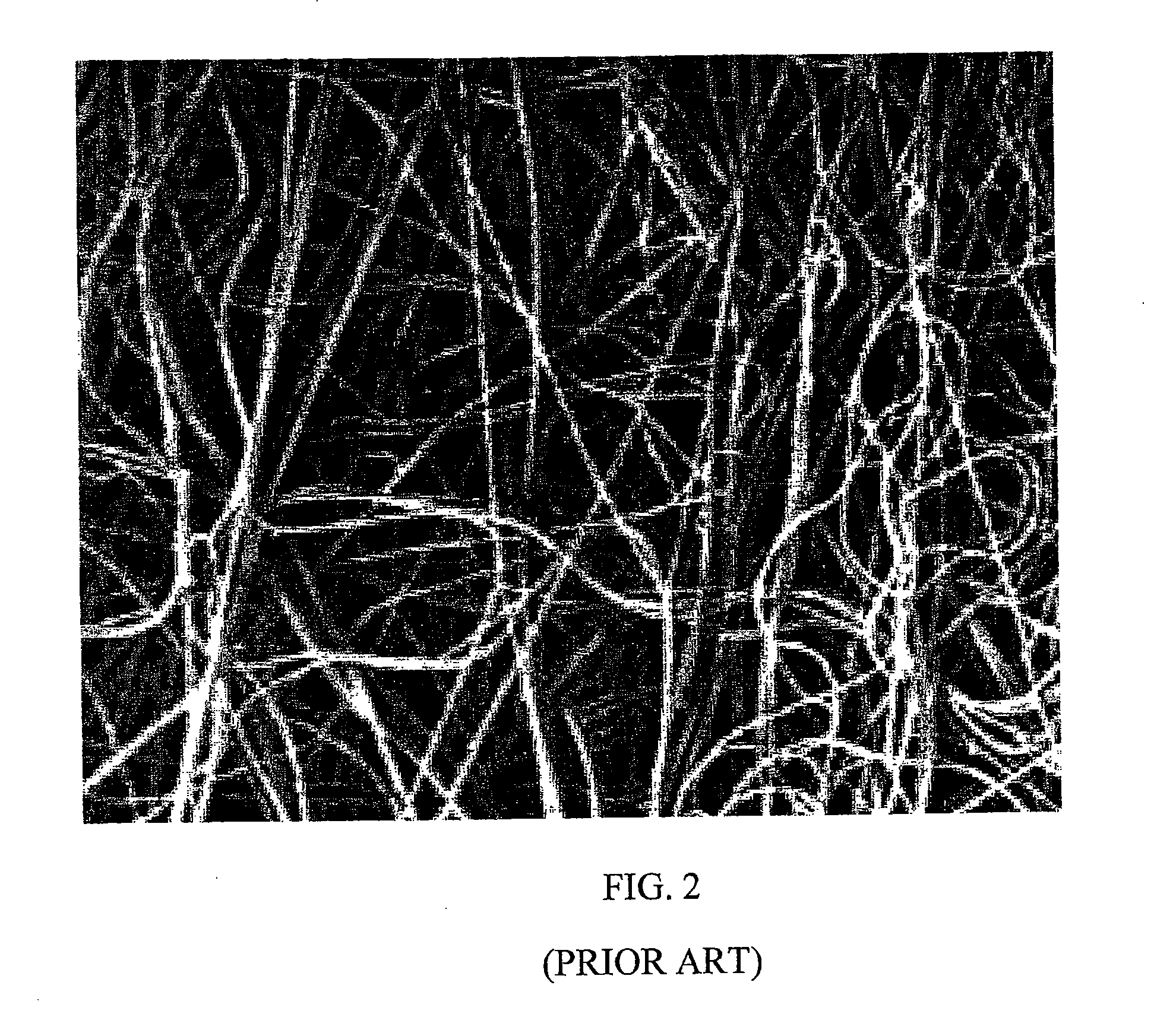[0013]A distinct advantage of the present invention is the ease in manufacturing through a wetlaid nonwoven fabrication process. Another distinct advantage is the resulting capability of providing any targeted level of pore size, porosity, and air resistance, through the mere change in proportions of component fibers utilized during the fabrication process. Yet another advantage of this inventive battery separator is the isotropic strength properties accorded the user for reliability in long-term use as well as during the battery manufacturing phase. The ability of the inventive separator to provide contemporaneous low air resistance and low pore sizes is still a further advantage of this invention. Yet another advantage of this inventive battery separator is the provision of a specifically non-conductive (and thus insulating) fabric that does not allow transmission of electrical charge through the separator body, but solely through the transport of charged ions through the pores present within its structure. Yet another advantage is the high porosity of the material, allowing more electrolyte to flow and increasing the durability of the ability to hold energy over many life cycles by allowing fully recharged electrodes.
[0014]Accordingly, this invention pertains to an insulating polymeric battery separator comprising a nonwoven combination of microfibers and nanofibers, wherein said separator provides sufficient porosity for electrolyte ion transfer therethrough and suitable prevention of electrode contact through a single layer of said nonwoven combination. A battery including such an insulating separator is likewise encompassed within this invention, as is the method of utilizing such a battery to generate electricity in a rechargeable device. Furthermore, a method of manufacturing an insulating polymeric battery separator through a wetlaid nowoven fabricating method wherein a plurality of polymeric microfibers of at least one polymeric component or a plurality of polymeric nanofiber of at least one polymeric component, or both of said plurality of polymeric microfibers and nanofibers, is combined in a high shear environment to form a slurry of a plurality of fibrillated polymeric microfibers and a plurality of nanofibers to form a single-layer fabric therefrom, is also included within this invention.
[0015]Throughout this disclosure, the term microfiber is intended to mean any polymeric fiber exhibiting a width that is measured in micrometers, generally having a fiber diameter greater than 1000 nm, but also greater than 3000 nm, or even greater than 5000 nm or possibly even greater than 10,000 nm, up to about 40 microns. As well, the term nanofiber is intended to mean any polymeric fiber exhibiting a width that is measured in nanometers, generally having a diameter less than 1000 nm, but possibly less than 700 nm, or even less than 500 nm or possibly even less than 300 nm (as low as about 1 nm). As well, the term insulating in intended to indicate no appreciable degree of electrical conductivity, and thus the inventive fabric structure does not permit electrical charge throughout the fabric body, but only through the passage of electrolytic ions through the pores present therein.
[0016]Such a combination of microfibers and nanofibers has yet to be investigated within the battery separator art, particularly in terms of the capability of providing a single-layer nonwoven fabric of the two base components for such a purpose. The microfiber constituent may be of any suitable polymer that provides the necessary chemical and heat resistance alluded to above, as well as the capability of forming a microfiber structure. As well, such a microfiber may also be fibrillated (or treated in any other like manner, such as through plasma exposure, and the like) during or subsequent to fiber formation in order to increase the surface area thereof to facilitate the desired entangling between a plurality of such microfibers during a nonwoven fabrication process. Such polymeric components may thus include acrylics such as polyacrylonitrile, polyolefins such as polypropylene, polyethylene, polybutylene and others including copolymers, polyamides, polyvinyl alcohol, polyethylene terephthalate, polybutylene terephthalate, polysulfone, polyvinyl fluoride, polyvinylidene fluoride, polyvinylidene fluoride-hexafluoropropylene, polymethyl pentene, polyphenylene sulfide, polyacetyl, polyurethane, aromatic polyamide, semi-aromatic polyamide, polypropylene terephthalate, polymethyl methacrylate, polystyrene, and blends, mixtures and copolymers including these polymers. Polyacrylates, polyesters, and polyolefins are potentially preferred.
[0017]The fibers may also be pre-treated with adhesives to effectuate the desired degree of contact and dimensional stability of the overall nonwoven structure subsequent to fabrication. The nanofibers may thus be of any like polymer constituency in order to withstand the same types of chemical and high temperature exposures as for the microfibers. Due to their size, there is no requirement of post-manufacture treatment of such nanofiber materials to accord any increase in entanglement on the produced nonwoven surface or within the interstices thereof. Importantly, however, is the necessity that the nanofibers combine with the microfibers under a sufficiently high shear environment to accord the desired introduction of such nanofibers onto and within the resultant microfiber nonwoven substrate simultaneously during actual nonwoven fabrication itself In other words, upon the provision of both types of fiber materials within the nonwoven production process, the manufacturer should accord a sufficient amount of mixing and high shear conditions to best ensure the proper degree of entanglement between the different fiber types to form the desired single-layer fabric structure. As well, the fabrication method is potentially preferred as a wetlaid nonwoven procedure in addition to the high shear type, ostensibly to best ensure the proper introduction and residual location of nanofibers within the microfiber interstices. With an increased water flow during manufacture, the extremely small nanofibers will be drawn into such interstices at a greater rate than with a dry entanglement method, thereby according the aforementioned interstice fill capability. The resultant nonwoven structure would thus exhibit greater uniformity in terms of thickness, porosity, and, most importantly, pore sizes, therein.
[0018]One method followed for such a wetlaid procedure includes the provision of pre-fibrillated microfibers in a pulp-like formulation, comprising, for example, up to about 80% by weight of an aqueous-based formulation (water alone is preferred, although other solvents that permit a wetlaid process and subsequent facilitation of evaporation thereof may be utilized, including, for instance, certain non-polar alcohols). The pre-fibrillated microfibers have been treated in such a manner, thus exhibiting a certain amount of already-present nanofibers (the residual product removed from the microfiber themselves during fibrillation, but not removed from the overall resultant mesh of microfibers thereafter). Such pre-fibrillated fibers are in pulp form as a result of the fibrillation procedure, rendering a slurry-like formulation including the above-noted aqueous-based solvent with the resultant pre-fibrillated microfibers and nanofibers. This slurry-like formulation is then mixed with selected amounts of other microfibers and / or nanofibers (preferably in pulp- or slurry-like form, as well), and the resultant formulation, having a very low concentration of actual fiber solids content therein (i.e., above 90% by weight of water or other aqueous-based solvent) is then subjected to a high shear environment with subsequent placement on a flat surface. The surface is sufficiently porous to allow for solvent elution, thus leaving the desired wetlaid nonwoven single fabric layer including fibrillated microfibers entangled with one another, and exhibiting interstices between each microfiber, as well as nanofibers present within such interstices and on the surface of the larger microfibers as well. The amount of added nanofibers to the pre-fibrillated microfiber pulp would thus accord greater amounts of fill between the microfiber interstices to provide an overall low mean pore size, particularly in comparison to a wetlaid nonwoven that is made solely from the pre-fibrillated pulp alone. Conversely, then, the addition of microfibers to the pre-fibrillated fiber slurry would accord a larger mean pore size to the resultant wetlaid nonwoven single layer fabric than the pre-fibrillated fiber slurry alone. This capability to target different mean pore sizes through nanofiber and / or microfiber addition levels accords the manufacturer the potential to achieve any desired mean pore size level. As well, the potential to calendar and otherwise alter the thickness of the resultant single layer fabric permits the manufacturer the further capability to allow for greater versatility in terms of both air resistance and mean pore size measurements. Such a dial-in process has yet to be explored within the battery separator industry.
 Login to View More
Login to View More 


